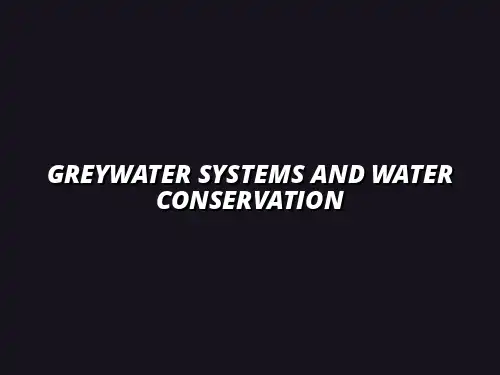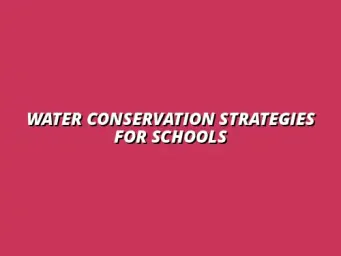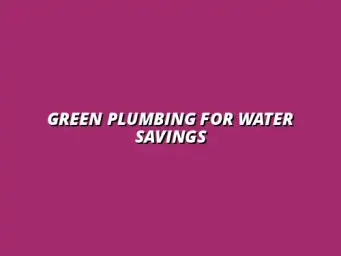The Importance of Water Conservation in Today's World
Water is one of our most precious resources, and conserving it has become increasingly important in recent years. With a growing population and changing climate, the demand for freshwater continues to rise, putting immense pressure on our water supplies. It's vital to understand how water conservation can play a crucial role in addressing these challenges. Implementing simple water-saving tips for your home can make a big difference.
By actively participating in water conservation efforts, we can help secure a sustainable future for our communities and the planet. Every drop counts, and small changes in our daily habits can lead to significant benefits. Let's delve into why conserving water is essential and what we can do about it!
Understanding Water Scarcity and Its Impact
Water scarcity affects billions of people around the world, making it a pressing global issue. It occurs when the demand for water exceeds the available supply, often due to factors like population growth, climate change, and pollution. Understanding this scarcity is crucial to grasping the serious implications it has on health, agriculture, and the environment. Consider the benefits of eco-friendly plumbing for your home.
When communities face water scarcity, it can lead to increased competition for resources, social unrest, and economic instability. To combat these issues, we must prioritize sustainable water management practices that help mitigate the impact of water scarcity.
- In 2020, around 2 billion people faced water scarcity.
- Water scarcity can lead to food insecurity as crops fail without sufficient irrigation.
- It significantly impacts public health, increasing the risk of diseases.
Global Water Crisis: Statistics and Facts
The global water crisis is alarming, with statistics that highlight the urgency of the situation. For instance, it is estimated that by 2025, two-thirds of the world’s population could be living in water-stressed conditions. Understanding these numbers can enhance our awareness of the necessity for effective water conservation strategies. Efficient irrigation systems are key, and you can learn more about the benefits of water-efficient irrigation.
Some key facts include:
- Over 785 million people lack basic access to clean water.
- Approximately 1.9 billion people live in areas with high water stress.
- Water demand is projected to increase by 55% globally by 2050.
The Role of Water in Sustainable Development
Water is not just a basic human need; it's also a critical component for sustainable development. It plays a vital role in various sectors such as agriculture, energy, and health. Ensuring access to clean and safe water is essential for reducing poverty and promoting economic growth. Regular maintenance, such as water heater maintenance, contributes to water efficiency.
Sustainable water management supports:
- Food security through irrigation and agriculture.
- Energy production by supporting hydropower and cooling systems.
- Public health by providing access to safe drinking water and sanitation.
By recognizing the integral role of water in our lives, we can better understand the importance of conservation and take steps to preserve it for future generations. Don't forget about rainwater harvesting as another effective conservation method.
Understanding Greywater: Definition and Sources
Greywater refers to wastewater generated from household activities like bathing, laundry, and dishwashing. Unlike blackwater, which comes from toilets, greywater is often less contaminated and can be treated and reused for various purposes. Understanding greywater is essential for implementing sustainable water conservation practices. Regular bathroom plumbing inspections can help identify potential greywater issues.
By recycling greywater, we can significantly reduce our demand for freshwater, making it a valuable resource. It's fascinating to think about how we can harness this "wastewater" for beneficial uses!
What Constitutes Greywater?
Greywater is the water produced from everyday activities, excluding toilet waste. It's essential to identify what qualifies as greywater to understand how we can reuse it effectively. Here are some common sources of greywater:
- Shower and bath water
- Sink water from kitchens and bathrooms
- Washing machine discharge
By recognizing these sources, we can work towards capturing and utilizing greywater in our homes and communities! Proper kitchen plumbing maintenance is also important for efficient water use.
Household Sources of Greywater
In households, greywater can come from various places. Understanding where it comes from helps us plan for its potential reuse. Some notable sources include:
- Bathroom sinks
- Bathtubs and showers
- Washing machines
Each of these sources contributes to the overall amount of greywater we generate, and with proper systems in place, we can recycle this water for irrigation and other non-potable uses.
Distinguishing Greywater from Other Wastewater Types
It's crucial to differentiate greywater from other types of wastewater, especially blackwater. Greywater is typically less contaminated, making it safer and easier to treat for reuse. Knowing these differences helps us make informed decisions about water recycling practices.
Here's a quick overview:
- Greywater: Non-hazardous, comes from sinks and showers.
- Blackwater: Contains human waste, requires more advanced treatment.
- Stormwater: Runoff from rain and storms, may carry pollutants.
Understanding these distinctions allows us to handle each type of wastewater appropriately and maximize our efforts in water conservation.
Implementing Greywater Systems: Practical Considerations
When thinking about installing a greywater system in your home, it’s important to understand the practical steps involved. This ensures you’ll be ready to efficiently recycle water from your sinks, showers, or washing machines. Let’s dive into the essential steps you should follow to get started on this sustainable journey!
Steps to Install a Greywater System in Your Home
The first step in installing a greywater system is to assess your home’s layout and plumbing. This will help you determine the best way to collect and route greywater. Here’s a quick checklist to guide you:
- Evaluate the sources of greywater in your home.
- Identify where the greywater will be reused, such as for irrigation.
- Consult a plumber or an expert to ensure proper installation.
After evaluating, the next phase involves selecting the right system that fits your needs. Depending on your home's plumbing and local regulations, options may vary widely. Researching various systems is crucial!
Assessing Your Home's Suitability for Greywater Recycling
Not every home is perfect for a greywater system. You'll need to consider factors like the layout of your plumbing and local regulations. Here's what to keep in mind:
- Distance from greywater sources to reuse locations.
- Soil type and drainage capabilities for irrigation.
- Local climate and its impact on water usage.
Taking the time to assess these factors will help you determine if greywater recycling is feasible in your case. Remember, understanding your home’s specific needs can save you time and money down the road!
Legal and Regulatory Considerations for Greywater Systems
Before diving into installation, it's vital to check your local laws regarding greywater systems. Regulations can differ significantly depending on where you live. Here are some key points to consider:
- Understand your local health department's regulations.
- Check if permits are needed for installation.
- Research any restrictions on greywater use in your area.
Staying informed about these legal aspects will help you avoid any fines or issues later on! Consulting with local authorities can provide clarity and guidance.
Case Studies and Success Stories of Greywater Systems
Seeing how others have successfully implemented greywater systems can be incredibly motivating. Real-world examples highlight the practicality and benefits of these systems. Let’s explore some inspiring case studies!
Real-World Applications of Greywater Recycling
Greywater recycling is being put to use in many different settings. From homes to businesses, the versatility of these systems shines through! Here are a few notable examples:
- A family in California reduced their water bill by 40% using a simple greywater system.
- A hotel in Arizona implemented greywater recycling for landscape irrigation, saving thousands of gallons.
- In Australia, farms use greywater for crop irrigation, demonstrating agricultural benefits.
These examples not only show the effectiveness of greywater systems but also inspire others to consider similar approaches. It’s amazing what can be achieved with a little innovation!
Examples from Residential Settings
Many homeowners are taking the plunge into greywater reuse. Here are a few inspiring stories:
- One couple installed a system that redirects water from their washing machine to their garden.
- A family reused shower water to irrigate fruit trees in their backyard.
- Another household created a simple filtration system to purify greywater for landscape use.
These residential successes highlight the practical, everyday benefits of adopting greywater systems. They have proven that conserving water can also be simple and effective!
Commercial and Agricultural Uses of Greywater
Greywater systems are not just for homes; they are thriving in commercial and agricultural settings too. Here are a few impactful examples:
- Restaurants recycle water from dishwashing for irrigation in their gardens.
- Golf courses use greywater to maintain their greens, reducing freshwater consumption.
- Farmers are using treated greywater to water crops, enhancing sustainability practices.
These applications underscore the potential of greywater reuse, showcasing its importance in various sectors. The benefits extend beyond individual households into broader community practices!
The Future of Greywater Systems in Sustainable Water Management
As we navigate the challenges of water scarcity, greywater systems are becoming increasingly relevant. Innovative technologies are paving the way for more efficient water management. Let’s look at what's on the horizon!
Innovative Technologies and Emerging Trends
New technology is constantly emerging to enhance greywater systems. Here are some exciting trends to watch for:
- Smart sensors that monitor water usage and optimize recycling.
- Advanced filtration systems that make greywater safer for reuse.
- Mobile apps that help homeowners track their water savings.
These innovations make greywater systems more accessible and effective. The future of water management truly looks promising with these advancements!
The Role of Smart Technology in Greywater Systems
Smart technology is changing the landscape of greywater systems. Using technology can streamline processes and make conservation more efficient. Here’s how:
- Automated systems that adjust based on rainfall and water demand.
- Digital dashboards that display real-time water usage metrics.
- IoT-connected devices that alert homeowners to maintenance needs.
Embracing smart technology can lead to greater water conservation, showing us that the future is indeed bright! These advancements support sustainable living practices for everyone.
Policy Developments and Support for Greywater Initiatives
Government policies are evolving to better support greywater systems. Many regions are recognizing the importance of sustainable practices. Some encouraging signs include:
- Incentives for homeowners to install greywater systems.
- Funding for research into greywater treatment technologies.
- Public awareness campaigns highlighting the benefits of greywater reuse.
Active governmental support for greywater initiatives will further promote community engagement in water conservation. It’s great to see policy aligning with sustainability goals!
Your Role in Water Conservation: Taking Action with Greywater Systems
As individuals, we all have a part to play in conserving water. Greywater systems offer a practical way to contribute to a sustainable future. Here’s how you can get involved!
Steps You Can Take to Contribute
Taking action starts at home! Here are a few easy steps you can take to promote greywater systems:
- Educate yourself and others about greywater benefits.
- Advocate for local policies that support greywater systems.
- Consider installing a greywater system in your home.
Your efforts can make a significant difference in your community’s water conservation efforts! Every small action adds up to create a larger impact.
Community Engagement and Advocacy for Greywater Systems
Engaging with your community can amplify your efforts. Here are some ways to promote greywater systems locally:
- Host workshops to educate others on greywater recycling.
- Partner with local organizations to advocate for sustainable practices.
- Share success stories to inspire others to adopt greywater systems.
Community engagement fosters a culture of sustainability, creating a ripple effect of conservation practices! Together, we can build a strong network focused on protecting our water resources.
Resources for Learning More about Greywater Recycling
Knowledge is key to successful greywater implementation. Explore various resources to enhance your understanding:
- Books and guides on greywater systems.
- Online courses focused on sustainable water management.
- Websites of organizations dedicated to water conservation.
Utilizing these resources can empower you to make informed decisions about greywater recycling. The more we learn, the better prepared we are to take action!
Reflecting on the Benefits of Greywater Systems for Sustainable Living
As we wrap up, let’s reflect on the key points surrounding greywater conservation. Implementing these systems is a proactive step towards a sustainable future! Here’s a quick summary:
Summary of Key Points on Greywater Conservation
Greywater systems provide numerous benefits, including:
- Reducing freshwater consumption significantly.
- Providing alternative water sources for irrigation.
- Encouraging a sustainable mindset in communities.
Remembering these benefits can motivate you to consider greywater systems as part of your water conservation efforts. Every action counts!
The Broader Impacts of Water Conservation Efforts
Water conservation impacts not just individual households but entire communities. Here are some broader effects to consider:
- Improved environmental health and biodiversity.
- Increased resilience against drought and water shortages.
- Enhanced community awareness of sustainable practices.
Embracing water conservation helps us build a healthier planet for future generations. It’s a winning situation for everyone!
Encouraging a Culture of Sustainability in Water Usage
By incorporating greywater systems, we can foster a culture of sustainability that prioritizes responsible water use. Here’s how to encourage this culture:
- Share your experiences to inspire others.
- Promote community events focused on water conservation.
- Support legislation that advances sustainable water practices.
Together, we can create a movement that values and conserves our most precious resource—water! Let’s take action for a sustainable future!










